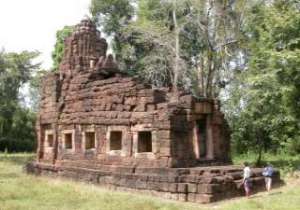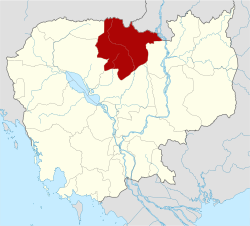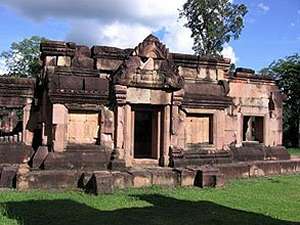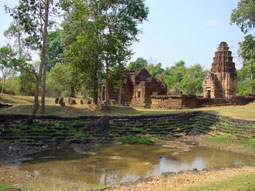Preah Vihear Province
Preah Vihear — Province —
Map of Cambodia highlighting Preah Vihear
Capital
Phnom Tbeng Meanchey
- Total : 13,788 km2 (5,323.6 sq mi)
Population (2008)
- Total : 170,852
- Density
12.4/km2 (32.1/sq mi)
Preah Vihear (sacred sanctuary) is a northern province of Cambodia. The capital is Phnom Tbeng Meanchey town.
Description
The province is named after the temple of Prasat Preah Vihear. The Dângrêk Mountains and the Cambodia/Thailand border are located in the north of Preah Vihear Province.
Preah Vihear is one of the nine provinces that is part of the Tonle Sap Biosphere Reserve.
Several Western governments have issued travel warnings to their citizens advising not to travel to this province due to an ongoing border dispute between Cambodia and Thailand. The Government of Canada has advised "Armed forces from both countries are engaged in this ongoing dispute. There have been reports of exchanges of gunfire in the area. Tensions are extremely high and military hostilities could escalate without warning."
Administration
The province is subdivided into 7 districts.
- 1301 - Chey Saen
- 1302 - Chhaeb
- 1303 - Choam Khsant
- 1304 - Kuleaen
- 1305 - Rovieng
- 1306 - Sangkom Thmei
- 1307 - Tbaeng Meanchey
PREAH VIHEAR Temple
Prasat Preah Vihear was built by a succession of several Khmer monarchs beginning with Yasovaraman I and ending with Suriyavaraman II, builder of Angkor Wat. This progressive construction appreciated once at the temple itself, as there are a series of gopura rising to the cliff. Some scholars has contented the site may have been founded earlier still, as evidenced by inscriptions linking it to the son of Jayavaraman II, the first of Angkor’s denaraja,who transported temple of Wat Phu Champasak in Laos.

Located at Svay Chrum Village, Kan Tout Commune, Choam Ksan District, on the mountain rank of Dang Rek (Preah Vihear mountain is 800 Meters x 400 Meters. Preah Vihear Mountain has very steep side from Cambodia and gently sloping side from Thailand. Preah Vihear temple has 405-Kilometer distance from Phnom Penh or 108-Kilometerdistance from the provincial town of Preah Vihear by road No 211 to the Choam Ksan District. Preah Vihear Temple has three accesses: – Access from Thailand for international tourists. – Access from Cambodia by the ancient road via Svay Chrum. At the mountain of Dang Rek, there is a stair stretching up the top where the Preah Vihear temple located. – Access from Cambodia by the Road C1 constructed by Khmer Rouge.

Nowadays, most local people and venders usually. – go up the mountain by the Road C1 because it is easy to go. Preah Vihear temple is the historical site named “Se Khari Svarak” means “power of mountain” and was built at the end of 9th century and at the beginning of 10th century by four Kings namely: – Preah Bat Sorya Varman I from AD 1002-1050. – Preah Bat Sorya Preah Bat Yak So Varman I from AD 889-910. – Varman II from AD 1113-1150. – Preah Bat Chey Varman VI from AD 1080-1109. Preah Vihear temple was handed over by France to Thailand in 1954 and given back to Cambodia by the verdict of the La Er International Court dated 15 June 1962.
BAK KAM PAGODA
Located at Bac Kam Village, Chhean Muk Commune, Tbeng Mean Chey District in 17-Kilometer distance from the provincial town of Preah Vihear. The area of the pagoda is 400 Meters x 1000 Meters. The local visitors usually visit the pagoda during the holidays or national festivals.
KOH KER TEMPLE

The distance from each temple is 2-5 Kilometers. Koh Ker temple located on the highland of Kork Koki and was built by Preah Bat Chey Varman IV from AD 921-942. It is the mountainous temple having seven decks and 35-meter height. The temple is not yet opened for tourists to visit because the area not yet arranged and has mines.

BAKAN TEMPLE

Ba Kan is the cultural site. Nowadays, the temple has no tourists to visit yet.
STEUNG KSACH RESORT
Is the natural resort, locates along the river of Sen at Thmey Village, Kampong Pra Nak Commune, Tbeng Mean Chey District in three-Kilometer distance from the provincial town by a trail. The resort has served the local visitors especially those who live in the provincial town of Preah Vihear with their leisure activities usually like swimming and boating during the national festivals. Preah Vihear Province has 228 ancient temples included:
- 108 temples in Ku Len District
- 16 temples in Sang Kum Thmey District
- 55 temples in Cham Ksan District
- 18 temples in Chheb District
- 11 temples in Ro Vieng District
- 11 temples in Chey Sen District
- 09 temples in Tbeng Mean Chey District
Prasat Ta Moan Thom
Prasat Ta Moan Thom means in Khmer “Great Temple of Grandfather Moan”. This south-facing temple enshrined a linga svayambhuva (‘self-born linga’), which might indicated that a linga was found at the site. The temple was the site of a hermitage during the pre-Angkor period. According to an inscription from the early years of Suryavarman I’s reign, the Prasat Ta Moan Thom was once named Shivapada pashcima - means “The Western Footprint of God Shiva”.
The early hermit community who venerated linga (representing hindu God Shiva) had built a wooden structure to shelter it (as it was the beginning of the construction of Prasat Preah Vihear). Later on a sandstone temple was built on the site to shelter the linga. The temple was built in phases, like in the case of Prasat Preah Vihear. The expansion of the temple was made to the south of the original site, where the slope fell steeply on the side of the hill. There are several linga on the rock-strewn ground.
The central sanctuary houses the ”Svayambhuva linga” that had been worshipped from very early times by a community of hermits. It is preceded by by a three-section pavillion (mandapa). Two libraries open to the west are located on both sides of the main shrine. Two more temples were added in the rear at a later date to the central sanctuaries. A rectangular enclosure (46 metres north-south and 36 metres east-west) consists of a series of galaries sourrounding the central sanctuary. There are three entrance gateways east, north and west, each with triple passageways. The main gate, the fourth gate, faces south, with a large Gopura (central hall). In front of the main gate, there is a high laterite esplanade overlooking the steep descent towards the Cambodian plain. In the rear outside of the enclosure, there is a water pond.
Prasat Ta Moan Thom grew in importance, especially from Jayavarman V’s reign onwards. There is a hospital and a Fire temple attached to it. At least Jayavarman VII had visited the temple once.
Prasat Ta Moan Toch
Prasat Ta Moan Toch means “a Small Temple of Grandfather Moan”. It serves as Khmer ‘hospital chapel’. The Khmers built many shrines known as ‘hospital chapels’ throughout the Khmer Empire. Jayavarman VII had built 102 such hospitals to place the sick under the protection of the ‘healing Buddha’ Bhaishajyaguru.
The classic layout of the hospital chapel of Ta Moan Toch seems to have been originally intended to open to all four cardinal points, bu the west, north and south doorways have been blocked up. The ground plan is idential for all the hospial chapels. The temple is enclosed within a wall of modest dimensions and consists of a sanctuary preceded by a mandapa (pavillion). There is a library open east through a pavillion. As usual located in the north-east corner, there is a laterite water pond characteristic of such chapels.
The Fire Shrine of Ta Moan
 The Ta Moan’s Fire Shrine is located some 1,500 metres north of Ta Moan Thom. All Khmer Fire Shrines are built to the same model: doors to the east and west and windows only on the south facade. The Fire Shrines have a special architechtural shape. They were built along the ancient main roads so that travellers could rest after a long walk. In present day’s Cambodia the Fire Shrine is called Sala Chhor Team, a cottage without wall where a traveller can rest and drink water. The Fire Shrines have been designated as dharmasala, but their Sanskrit name means “the house of fire”.
The Ta Moan’s Fire Shrine is located some 1,500 metres north of Ta Moan Thom. All Khmer Fire Shrines are built to the same model: doors to the east and west and windows only on the south facade. The Fire Shrines have a special architechtural shape. They were built along the ancient main roads so that travellers could rest after a long walk. In present day’s Cambodia the Fire Shrine is called Sala Chhor Team, a cottage without wall where a traveller can rest and drink water. The Fire Shrines have been designated as dharmasala, but their Sanskrit name means “the house of fire”.
The building of Fire Shrines began since the reign of Suryavarman I until the reign of Jayavarman VII who had commissioned the building of many such dharmasala.




No comments:
Post a Comment